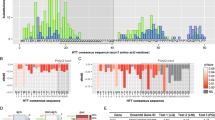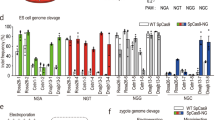Abstract
The Huntington’s disease mutation has been identified as a CAG/polyglutamine repeat expansion in a large gene of unknown function. In order to develop the transgenic systems necessary to uncover the molecular pathology of this disorder, it is necessary to be able to manipulate highly expanded CAG repeats in a cloned form. We have identified a patient with an expanded allele of greater than 170 repeat units and have cloned the mutant allele in the lambda zap vector. The recovery of highly expanded repeats after clone propagation was more efficient when repeats were maintained as lambda phage clones rather than as the plasmid counterparts. Manipulation of the repeats as phage clones has enabled us to generate Huntington’s disease transgenic mice that contain highly expanded (CAG)115–(CAG)150 repeats and that develop a progressive neurological phenotype.
Similar content being viewed by others
Author information
Authors and Affiliations
Additional information
Received: 7 October 1996 / Revised: 5 December 1996
Rights and permissions
About this article
Cite this article
Sathasivam, K., Amaechi, I., Mangiarini, L. et al. Identification of an HD patient with a (CAG)180 repeat expansion and the propagation of highly expanded CAG repeats in lambda phage. Hum Genet 99, 692–695 (1997). https://doi.org/10.1007/s004390050432
Issue Date:
DOI: https://doi.org/10.1007/s004390050432




